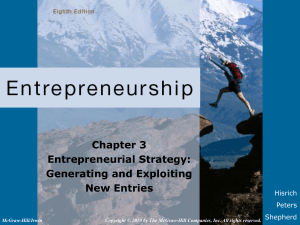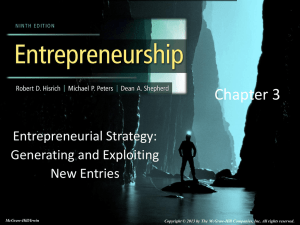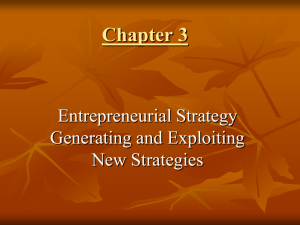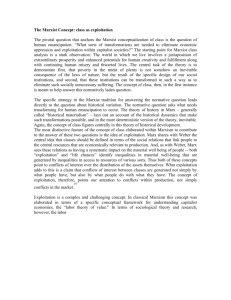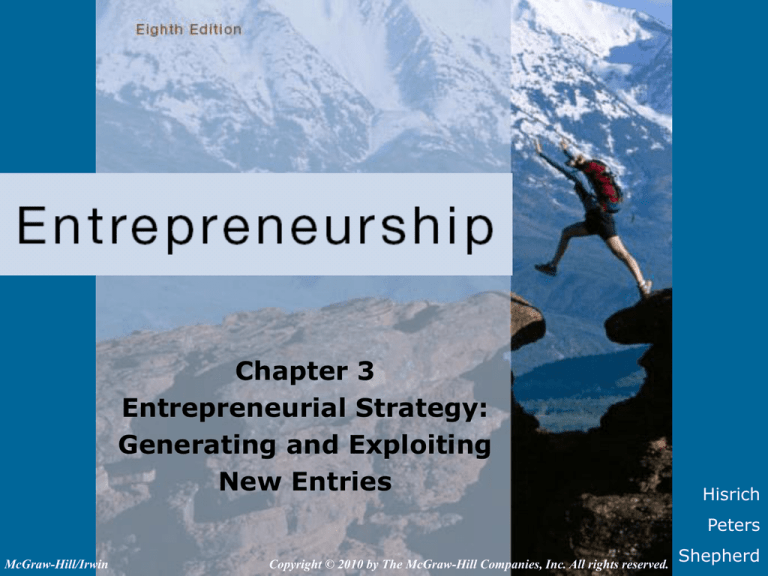
Chapter 3
Entrepreneurial Strategy:
Generating and Exploiting
New Entries
Hisrich
Peters
McGraw-Hill/Irwin
Copyright © 2010 by The McGraw-Hill Companies, Inc. All rights reserved.
Shepherd
Entrepreneur’s Adage #9
“Don’t start a business because you need
to… start a business because you can and
because there’s a market opportunity.”
- Jordan
3-2
New Entry
New entry refers to:
Offering a new product to an established or new
market.
Offering an established product to a new
market.
Entrepreneurial strategy – The set of
decisions, actions, and reactions that first
generate, and then exploit over time, a new
entry.
3-3
Entrepreneurial Strategy:
The Generation and Exploitation of New Entry
Opportunities
3-4
Generation of a New Entry Opportunity
Resources as a Source of Competitive
Advantage
Resources (Core Competencies) are the basic
building blocks of a firm’s functioning and
performance; the inputs into the production
process.
Resources must be:
Valuable.
Rare.
Inimitable.
3-5
Generation of a New Entry Opportunity
(cont.)
Creating Resource Bundles That Are
Valuable, Rare, and Inimitable
Entrepreneurs need to draw from their unique
experiences and knowledge.
Market knowledge – Provide insight into a
market and its customers.
Technological Knowledge - Provide insight
into ways to innovate processes and technology.
3-6
Generation of a New Entry Opportunity
(cont.)
Gathering Information on a New Entry
Prior knowledge and information search costs
More knowledge ensures a more efficient search
process (lower search costs).
Search costs include time, money and psychological
cost.
3-7
Generation of a New Entry
Opportunity (cont.)
Comfort with Making a Decision under
Uncertainty
The trade-off between more information and the
likelihood that the window of opportunity will
close provides a dilemma for entrepreneurs.
Error of commission - Negative outcome from acting
on the perceived opportunity.
Error of omission - Negative outcome from not acting
on the new entry opportunity.
3-8
The Decision to Exploit or Not to Exploit
the New Entry Opportunity
3-9
Entry Strategy for New Entry Exploitation
First Mover - advantages:
Cost advantages
Less (or no) competitive rivalry
The opportunity to secure important supplier
and distributor channels
Create the category position
The opportunity to gain expertise through
market participation
Brand equity: “Pioneer Admiration”
3-10
Entrepreneur’s Adage #10
“Don’t waste time on useless networking.
Choose your events wisely. Network
online. Sometimes the best networking is
the phone book.”
- Jordan
3-11
Entry Strategy for New Entry Exploitation
(cont.)
First-Mover Disadvantages
Demand uncertainty - Difficulty in estimating
the potential size of the market, how fast it will
grow, and the key dimensions along which it will
grow.
No “role model” to follow.
3-12
Entry Strategy for New Entry Exploitation
(cont.)
Technological uncertainty - Difficulty in
assessing whether the technology will perform
and whether alternate technologies will emerge
and leapfrog over current technologies.
Adaptation Difficulties - Hardship in adapting
to new environmental conditions.
Entrepreneurial attributes of persistence and
determination can inhibit the ability of the
entrepreneur to detect, and implement, change.
3-13
Entry Strategy for New Entry Exploitation
(cont.)
First-Mover Disadvantages, cont.
Customer Uncertainty - Difficulty in accurately
assessing whether the new product or service
provides value for them.
Overcome customer uncertainty by:
Informational advertising
Creating a frame of reference for potential customer
Educating customers through demonstration and
documentation
Beta-testing
3-14
Entry Strategy for New Entry Exploitation
(cont.)
Lead Time Strategies for First-Movers
Lead time – The grace period in which the first
mover operates in the industry under conditions
of limited competition.
Extend lead time by:
Building customer loyalties.
Building switching costs.
Protecting product uniqueness.
Securing access to important sources of supply and
distribution.
3-15
Risk Reduction Strategies for
New Entry Exploitation
Risk is derived from uncertainties over
market demand, technological
development, and actions of competitors.
Three strategies can be used to reduce
risk:
Market scope strategies - Focus on which
customer groups to serve and how to serve
them.
Imitation strategies - Involves copying the
practices of others.
Managing newness
3-16
Risk Reduction Strategies for
New Entry Exploitation (cont.)
Market Scope Strategies
Narrow-scope (niche) strategy: offer a small
product range to a small number of customer
groups to satisfy a specific need.
Focuses on producing customized products.
Leads to specialized expertise and knowledge.
Reduces some competition-related risks but increases
the risks associated with market uncertainties.
3-17
Risk Reduction Strategies for
New Entry Exploitation (cont.)
Broad-scope strategy: offer a wider range of
products to multiple different market segments,
catering to different sets of needs.
Strategy typically emerges through continuous learning
about the market.
Opens the firm up to many different “fronts” of
competition.
Reduces risks associated with market uncertainties but
increases exposure to competition.
3-18
Risk Reduction Strategies for
New Entry Exploitation (cont.)
Imitation Strategy
Why do it?
It is easier to imitate the practices of a successful firm.
It can help develop skills necessary to be successful in
the industry.
It provides organizational legitimacy.
Types of imitation strategies
Franchising - A franchisee acquires the use of a
“proven formula” for new entry from a franchisor.
“Me-too” strategy - Copying products that already exist
and attempting to build an advantage through minor
variations.
3-19
Risk Reduction Strategies for
New Entry Exploitation (cont.)
An imitation strategy can potentially:
Reduce the entrepreneur’s costs associated with R&D.
Reduce customer uncertainty over the firm.
Make the new entry look legitimate from day one.
3-20
Risk Reduction Strategies for
New Entry Exploitation (cont.)
Managing Newness
Liabilities of newness arise from unique
conditions:
Experience curve costs in learning new tasks.
Conflict arising from overlap or gaps in responsibilities.
Unestablished and continually evolving informal
structures of communication.
A new firm needs to:
Educate and train employees.
Facilitate conflict over roles.
Promote activities that foster informal relationships and
a functional corporate culture.
3-21
Entrepreneur’s Adage #11
“Steal ideas from others legally.”
- Jordan
3-22

